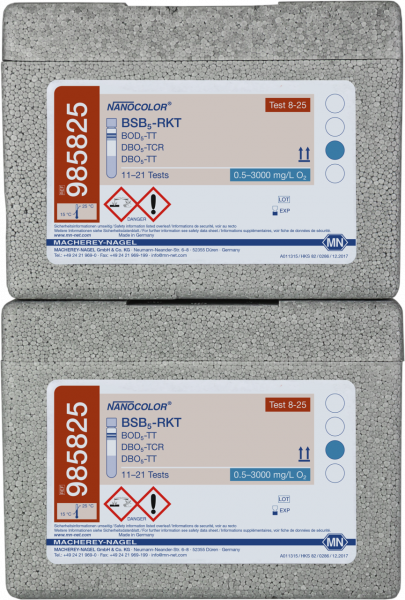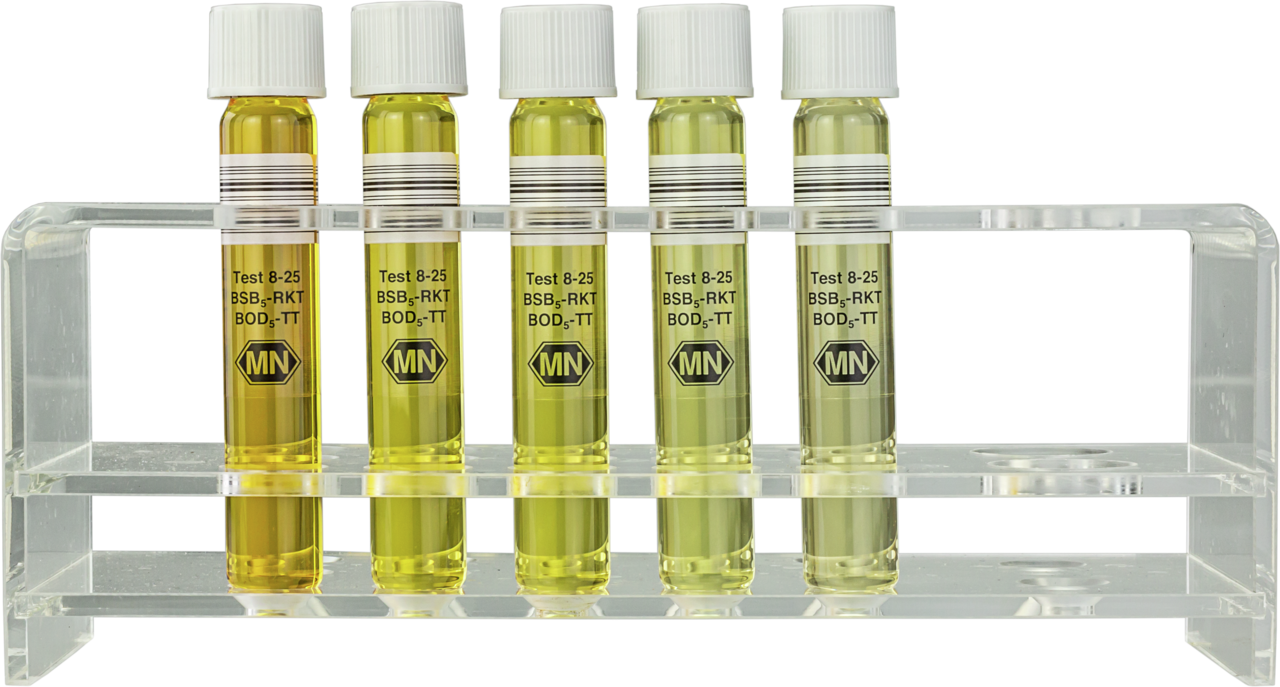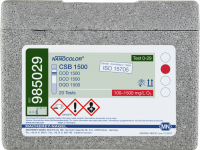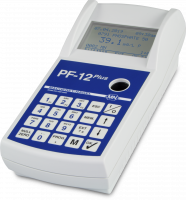Tube test NANOCOLOR BOD₅-TT
*taxes and shipping not included
Delivery time approx. 5 working days
Tube test for the determination of BOD₅ in test tubes. Precise rapid tests for all kind of water and waste water analysis. Time-saving and reliable analysis together with our NANOCOLOR photometers.
| Brand | NANOCOLOR |
| Platform | NANOCOLOR tube tests |
| Parameter | BOD₅ |
| Measuring range | BOD₅ - 0.5–3000 mg/L O₂ |
| Sludge reagent set | No |
| Test No. | 8-25 |
| Evaluable on | 500 D, Advance, MT Easy UV, MT Easy VIS, PF-12Plus, UV/VIS II, VIS II |
| Based on norm | Analogous to DIN EN 1899-1 – H51 + DIN EN 25813 – G 21 |
| Method | BOD₅ - Winkler |
| NanOx N | No |
| NanOx Metal | No |
| Crack-Set | No |
| Sea water analysis | Yes |
| Application | groundwater, surface water, wastewater |
| Test range | Low |
| Test method | Photometric |
| Remark | Measuring range on NANOCOLOR VIS II |
| Shelf life (from production) | 2 Year(s) |
| Storage temperature | 15–25 °C / 59–77 °F |
| Scope of delivery | 2 rugged boxes with 22 test tubes. Sufficient for 22 tests. |
| Gross weight (incl. packaging) | 545.8 g / 1.2 lbs |
| Packaging dimensions | 160 x 110 x 250 mm / 6.30 x 4.33 x 9.84 Inch |
| Hazardous material | Yes |
- Download Instruction / Anleitung / Manuel
- Download Pictogram / Piktogramm / Pictogramme
- Download Betriebsanweisung (DE)
- Download Flyer NANOCOLOR analysis system (EN)
- Download Flyer Das NANOCOLOR Analysensystem (DE)
- Download Flyer Système d’analyse NANOCOLOR (FR)
- Download Schritt für Schritt Anleitung (DE)
- Download NANOCOLOR analysesysteem (NL)
BOD5 - biochemical oxygen demand in 5 days
Besides the chemical oxygen demand (COD), the biochemical oxygen demand after 5 days (BOD5) is the most important cumulative effect parameter for assessment of the degree of contamination of a water body.
The BOD is defined by the volume-related amount of oxygen which is consumed by micro-organisms to degrade the organic matter present in the water at 20 °C by oxidation. In general, this determination is made after 5 days, why it is often referred to the BOD5 value.
BSB5 analysis with the tube test NANOCOLOR BSB5 -TT
General information
The BOD provides information on the biologically utilizable portion of organic contents in the sample solution. The determination is made by the measurement of the consumption of oxygen required for the oxidative degradation. The information is indicated in mg/L O2.
Alternatively, the carbon dioxide content can be measured instead of the oxygen content by so-called respirometric methods. Added sodium hydroxide reacts with the developing CO2 gas to form sodium carbonate, which creates a negative pressure.
The more organic nutrients are present in the sample, the higher is the metabolic activity of the bacteria and hence the resulting BOD value. A statement about the quality of a water sample and its biological activity can be made based on the BOD value.
- A high BOD value corresponds to a high concentration of readily degradable organic substances.
- A low BOD value can be caused by a low concentration of biologically utilizable substances, by poorly degradable compounds or by a disturbed determination of the BOD value.
The BOD is often evaluated in the context of the COD. If the difference between the two values is small, the sample consists mostly of readily biodegradable substances. If the difference is, however, very large, this can be attributed to a poor bio-degradability.
Nitrogen degradation also takes place, in addition to carbon degradation, in the sample solution. Nitrogen degradation, also known as nitrification, is the conversion of ammonia into nitrate. This happens also under oxygen consumption. In general, nitrification occurs later than carbon degradation. Nitrification inhibitors are used in order to exclude any disturbance on the BOD that might nevertheless occur, especially in lightly contaminated samples. The most commonly used compound is N-allylthiourea (ATH or NATH).
At high BOD concentrations, the sample must be treated with dilution water. Dilution water is unchlorinated tap water aerated for at least one hour in the dark. The oxygen concentration of the dilution water should be at least 8 mg/L.
Inoculating water, which is aerated inoculated dilution water, must be used for dilution, if the sample was frozen or does not contain enough micro-organisms. Inoculating water is obtained from microorganism-rich water such as sedimented municipal wastewater from the runoff of the primary treatment or from the mechanical feed. More information can be found in the instruction leaflet of the BOD accessories set (REF 916 925).
HOCl = Hypochlorous acid
OCl- = Hypochlorite ion
NH2Cl = monochloramine
NHCl2 = dichloramine
NCl3 = trichloramine
Total chlorine = free chlorine + combined chlorine
Reaction basis
The BOD content is determined by measuring the oxygen concentration. Micro-organisms consume oxygen during the degradation of organic substances into carbon dioxide.
The simplified determination of the biochemical oxygen demand after 5 days (BOD5) is done with undiluted samples and without using a control in accordance with the German norm DIN EN 1899-2-H52. The oxygen-enriched, undiluted sample is incubated in a test tube for 5 days at 20 ± 1 °C in the dark. The determination of the dissolved oxygen after 5 days is based on the Winkler method. The incubation of the sample and the oxygen measurement (after 5 days) take place in the same test tube (REF 985 825). In the standard method, the BOD5 is determined according to the so-called dilution principle. The oxygen concentration is measured immediately after sample preparation and after five days of incubation in Winkler bottles (REF 985 822). This method is in accordance with the German norm DIN EN 25813-G21.

Sample preservation
- Store the sample immediately after collection in a completely filled (no air bubbles!), tightly sealed bottle at a temperature of 1–5 °C in the dark until the performance of the test.
- Start the test as soon as possible, at the latest after 24 hours. Freeze the sample for longer storage.

Tips & tricks
Background information
- The test measures the oxygen consumption. A too high oxygen consumption of the dilution water leads to incorrect results. When using dilution water, measure the oxygen content of the control sample on day 0 (must be at least 8 mg/L O2) and on day 5 before starting the measurements. If the oxygen concentration difference of the control sample is greater than 2 mg/L O2, the oxygen degradation of the dilution water is too high. Possibly increase the aeration time or check for interfering ions.
- The same as described above applies when inoculating water is used instead of dilution water. The inoculating water must not have a high oxygen consumption. Again, oxygen measurements on day 0 and on day 5 before starting the analysis are recommended. The COD content of the inoculating water should be checked, if the oxygen consumption is too large. The COD content should be lower than 300 mg/L O2. For higher COD concentrations, use less or if possible no inoculating water for the dilution water.
Sea water suitability
- Sea water analysis is possible.
pH
- The pH value must be between 6 and 8. pH values outside this range lead to incorrect results. If the pH is too high adjust with 0.1 N sodium hydroxide, if it is too low adjust with 0.1 N hydrochloric acid.
Interferences
- Accumulations of special microbial metabolites and substances toxic for micro-organisms (e.g. mycotoxins, free chlorine, certain heavy metals) can lead to reduction of the substrate conversion and thus to reduction of the BOD5.
- Iron(II) salts, sulfur dioxide and hydrogen sulfide consume oxygen and also distort the BOD5 test result.
- Presence of algae or nitrifying micro-organisms can lead to increased results.
- Free and / or bound chlorine has to be removed by adding a suitable amount of sodium sulfite.


















